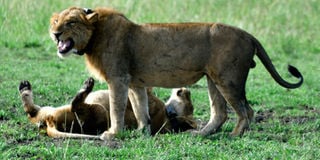Off-track and up-close with lions, leopards

Lions get playful in Queen Elizabeth National Park. PHOTO BY EDGAR R. BATTE
For a fulfilling excursion, you would count on luck to see a lion and leopard let alone up-close. To a tourist, the two wild animals are a prized sight. A recent trip served me the rare opportunity thanks to a visit by conservationists from Oakland Zoo, California hosted by Uganda Carnivore Programme (UCP) whose activities they support.
The team
Dr Ludwig Siefert UCP’s team leader is often called upon by Uganda Wildlife Authority (UWA) to safeguard the health of animals in Uganda’s savannah parks, with a particular focus on predators. With his assistant, James Kalyewa, we were led on an off-track experience that brought us face to face with the sought after wild animals.
Dr Siefert was driving while Kalyewa sat atop their Land Rover holding out the aerial in search of a signal of the lions and leopards.
The wildlife is collared with metallic bangles that have trackers and the experts use an aerial signal to know where the animals are.
The German-born wildlife veterinarian has been researching, practicing and teaching in Uganda since the early 1970s. Well, it did not take long before he located the wildlife and led us to the thickets were the leopards were taking a morning rest in the grasslands of Queen Elizabeth National Park.
Leopards out
Leopards did not show up. Kalyewa had to throw some raw and bloody meat to get the spotted animals out. When they emerged, faces of the tourists lit up as they whipped out their professional and phone digital cameras to capture the wild cat.
As they took bites into the pieces of fresh flesh, they cracked bones too therein. The cameras clicked endlessly and there were inaudible murmurs among the tourists.
A refreshing breeze swept through the grass.
We got to learn that for Kalyewa and Dr Seifert to offer the off-track experiences, one has to book through UWA at $50 (approximately Shs180,000) per head. The duo needs to be free and available to do the excursion. Also, some tourists donate $10 towards conservation of leopards and lions.
The lions
Then we sighted three lions. They took it slowly and lazily at the mid-morning hour. One couple was amiable and animated too as they played and groomed one another. You could think they were readying for a photo shoot. For an hour or so, in our presence, they unconsciously saw to it that we were entertained. The largely foreign visitors seemed not to have enough of the moment.
I bet some camera cards took hundreds of photographs.
Kalyewa used the moment to share some information. He told the attentive audience that Queen Elizabeth National Park is a popular tourism destination in Uganda, thanks to its Ishasha section where tourists sometimes get lucky to see the tree climbing lions.
Thanks to the cats
Well, my friend Phillip Kiboneka who was kind to host me during the trip at his Kasenyi Safari Camp, is an avid wildlife lover. Kiboneka has taken advantage of being resident in the park to document the animals in there.
“People come to Queen primarily to see lions and leopards. Without those two, I don’t think Kasenyi Safari Camp would be there. We would not have business,” he said.
“You can’t get tired of seeing a lion. Every day, their behaviour is different, from being so powerful yet so gentle to their young ones [cubs],” he explained.
We boarded the Land Rover and headed back to our meeting point. This was fulfilling and I wished I could have more time there.
Quick bio
Queen Elizabeth National Park
At 1,978 square kilometres, the park is home to over 95 mammal species and over 600 bird species. While in the park, you can take a cruise on the Kazinga Channel which has a number of hippos, bird species and more.
You can take a game drive to see more. If you are a cultural enthusiast, the Kikorongo Equator Cultural Performers are an energetic group to sort




